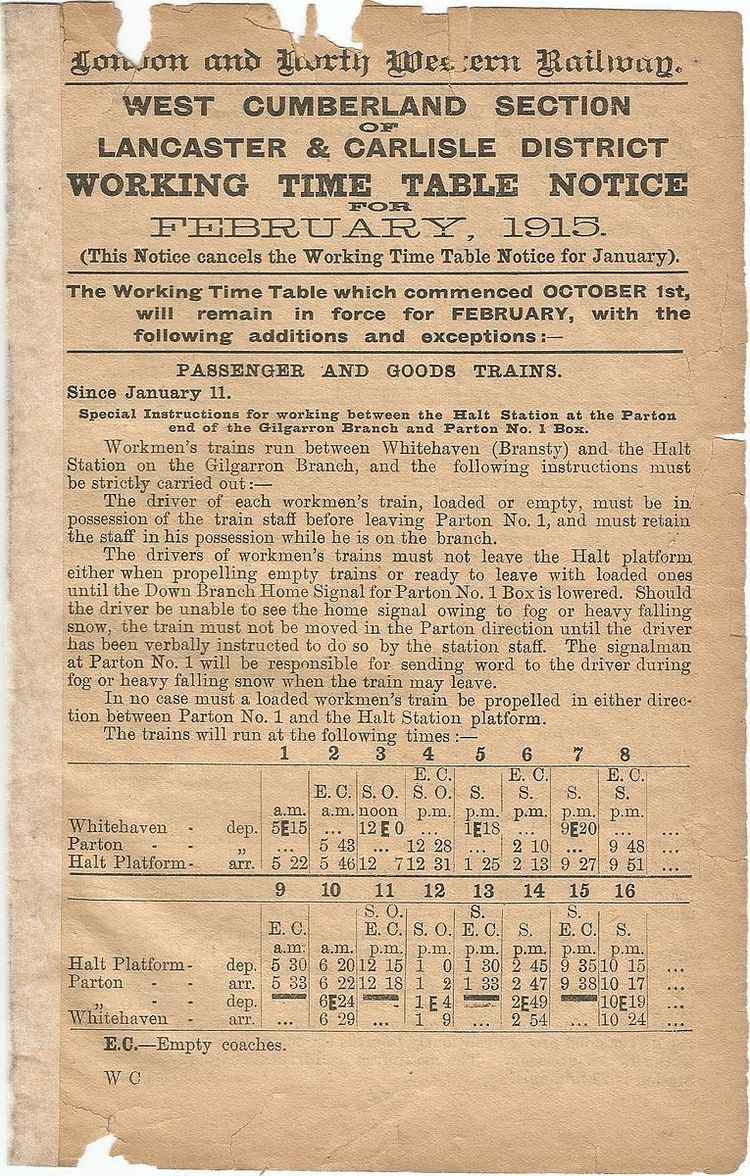Platforms in use 1 | Grid reference NX980210 | |
 | ||
Original company LNWR & Furness Joint Railway 1 January 1915 Opened to workmen's trains People also search for Buckhill Colliery Halt railway station | ||
Parton Halt railway station was opened by the LNWR and FR Joint Railway ("The Joint Line") in January 1915 and closed by the LMSR fourteen years later in 1929.
Contents
The halt never appeared on any public timetable, as it was provided to enable workmen to get from Whitehaven to the isolated colliery, coke ovens and bi-products plant on the hilltop at Lowca. The halt was at the foot of steep tracks up to these workplaces.
Location
The line past the halt is clearly shown on standard railway maps, but the halt eludes them all; however, it is shown on contemporary OS maps. It is not to be confused with Parton which in 2015 remained on the Cumbrian Coast Line 25 chains (0.50 km) to the south of the site of the halt.
Further research is needed to establish the physical nature of the halt, such structures in many parts of the country were very rudimentary.
History
The halt was on the WCER's Gilgarran Branch, occasionally referred to as the Gilgarron Branch. The company and the branch were fruits of the rapid industrialisation of West Cumberland in the second half of the Nineteenth Century.
All lines in the area were primarily aimed at mineral traffic, notably iron ore, coal and limestone, few more so than the Gilgarran Branch. Many iron mines, quarries, collieries and attendant works were situated in inaccessible areas with low populations, making workmen's trains a natural add-on service. Lowca had a workmen's service - and for a shorter period an advertised passenger service - from the north along the clifftops provided by the Lowca Light Railway in conjunction with the Cleator and Workington Junction Railway (CWJR). The service to Parton Halt met the same need from the south.
Services
No Sunday passenger service was provided.
A passenger service from Whitehaven to Distington along the Gilgarran Branch had run from 1881 to 1883, but it was not a success and was withdrawn. A Thursdays and Saturdays Only (Market Days) service was run from Whitehaven to Distington, calling at Parton from November 1913 to September 1914, these trains passed the site of the future Parton Halt, but served a different purpose.
The initial service can be seen on the attached Working Time table (WTT) from February 1915. Service times were set to match shift changes at the colliery and associated works. This was a common pattern with such halts across the country.
It is most unlikely that goods trains ever called at the halt.
Mineral traffic passed the halt, but did not call. The April 1917 Working Time Table shows three Up mineral trains travelling a mile beyond the halt to No 4 Pit and two travelling beyond to Distington Ironworks, with an extra on Saturdays, all matched by Down trains.
The line past the site of the halt went on to become a late survivor on the West Cumberland scene. The colliery at Lowca wound coal until 1968, feeding the associated works. After it closed coal continued to come from Solway Colliery, Workington until it closed in 1973, at which point the surviving business for the bi-product works and coal washery at Lowca was handled by road. The end products from Lowca were taken away northwards along the clifftops using the surviving parts of the Lowca Light Railway. Incoming coal from Solway Colliery was worked south along the coast line to Parton, where the train reversed 1 mile 11 chains (1.8 km) up the Gilgarron Branch, past the site of the halt to a junction known as "Bain's Siding" where it ran forward up the side of the valley to Lowca, effecting a zig-zag to gain the necessary height. Until 1968 at least, coal was also wound at No.4 Pit near Bain's Siding and taken down the branch past the site of the halt.
Rundown and closure
The halt closed in 1929, with buses able to provide a more attractive door-to-workplace gate service. The line past its site closed in May 1973. Nearby sidings were retained for many more years for Civil Engineers, but have since been lifted.
Afterlife
By 2013 most of the trackbed through the halt had been obliterated. Further towards Distington the Gilgarran Branch's route had been recycled as a public cycleway.
